|
CHAPTER ONE: THE ETIQUETTE OF COURTSHIP
Perfect Behavior | ||
1. CHAPTER ONE: THE ETIQUETTE OF COURTSHIP
A FEW WORDS ABOUT LOVE
COURTSHIP is one of the oldest of social customs, even antedating in some countries such long-established usages as marriage, or the wearing of white neckties with full evening dress. The beginnings of the etiquette of courtship were apparently connected in some way with the custom of "love" between the sexes, and many of the old amatory forms still survive in the modern courtship. It is generally agreed among students of the history of etiquette that when "love" first began to become popular among the better class of younger people they took to it with such avidity that it was necessary to devise some sort of rules for the conduct of formal or informal
Suppose, for example, that you are a young gentleman named Richard Roe desirous of entering upon a formal courtship with some refined young girl of fashion. You are also, being a college graduate, engaged in the bond business. One morning there comes into your financial institution a young lady, named Dorothy Doe, who at once attracts your attention by her genteel manners, as exemplified by the fact that she calls the president of your company "father." So many young people seem to think it "smart" to refer to their parents as "dad" or "my old man"; you are certain, as soon as you hear her say "Hello, father" to your employer, that she is undoubtedly a worthy object of courtship.
CORRECT INTRODUCTIONS; HOW TO MAKE THEM
YOUR first step should be, of course, the securing of an introduction. Introductions still play an important part in social
This brings up the interesting question of introducing two people to each other, neither of whose names you can remember. This is generally done by saying very quickly to one
The "introduction," in cases where you have no mutual friend to do the introducing, is somewhat more difficult but can generally be arranged as follows:
Procure a few feet of stout manila rope or clothes-line, from any of the better-class hardware stores. Ascertain (from the Social Register, preferably) the location of the young lady's residence, and go there on some dark
When she has accepted your cards, she will give you one of hers, after which it will be perfectly correct for you to assist her to rise from the sidewalk. Do not, however, press your attentions further upon her at this time, but after expressing the proper regret over her misfortune it would be well to bow and retire.
CARDS AND FLOWERS
THE next day, however, you should send flowers, enclosing another of your cards. It might be well to write some message on the card recalling the events of the preceding
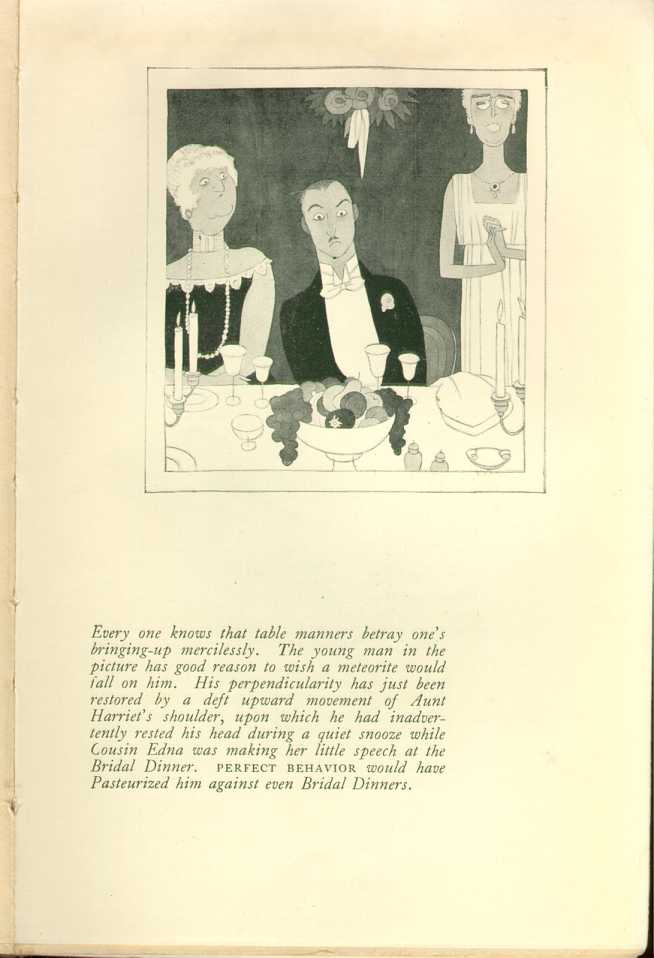
Every one knows that table manners betray one's bringing-up mercilessly. The young man in the picture has good reason to wish a meteorite would fall on him. His perpendicularity has just been restored by a deft upward movement of Aunt Harriet's shoulder, upon which he had inadvertently rested his head during a quiet snooze while Cousin Edna was making her little speech at the Bridal Dinner. PERFECT BEHAVIOR would have Pasteurized him against even Bridal Dinners.
[Description: Drawing of a man sitting at a dinner table, leaning to one side. An older woman sits on one side of him; another woman stands at his other side with her hands clasped together. ]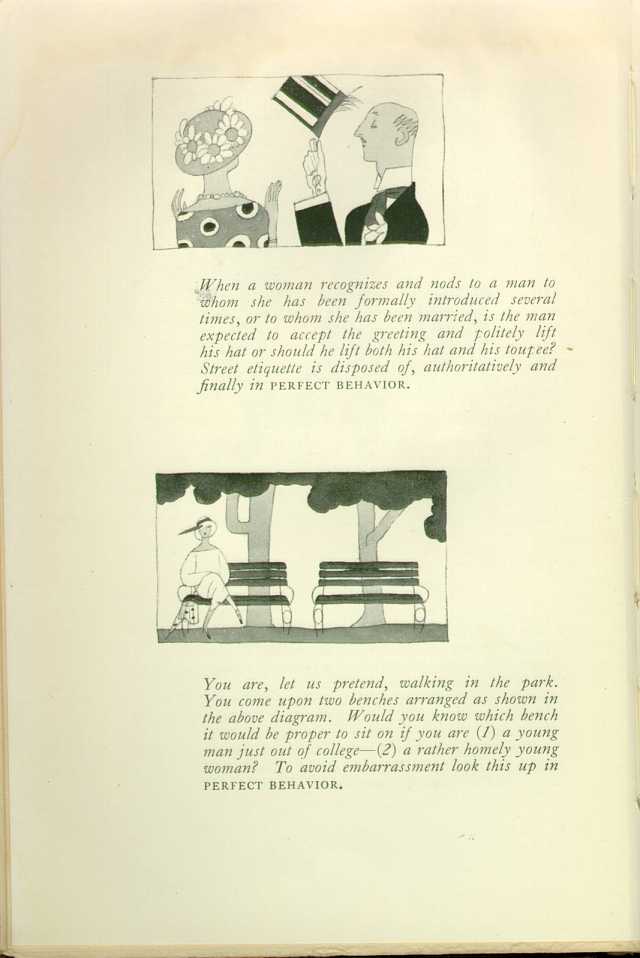
When a woman recognizes and nods to a man to whom she has been formally introduced several times, or to whom she has been married, is the man expected to accept the greeting and politely lift his hat or should he lift both his hat and his toupee? Street etiquette is disposed authoritatively and finally in PERFECT BEHAVIOR.
[Description: Drawing of a man tipping his hat to a woman. ]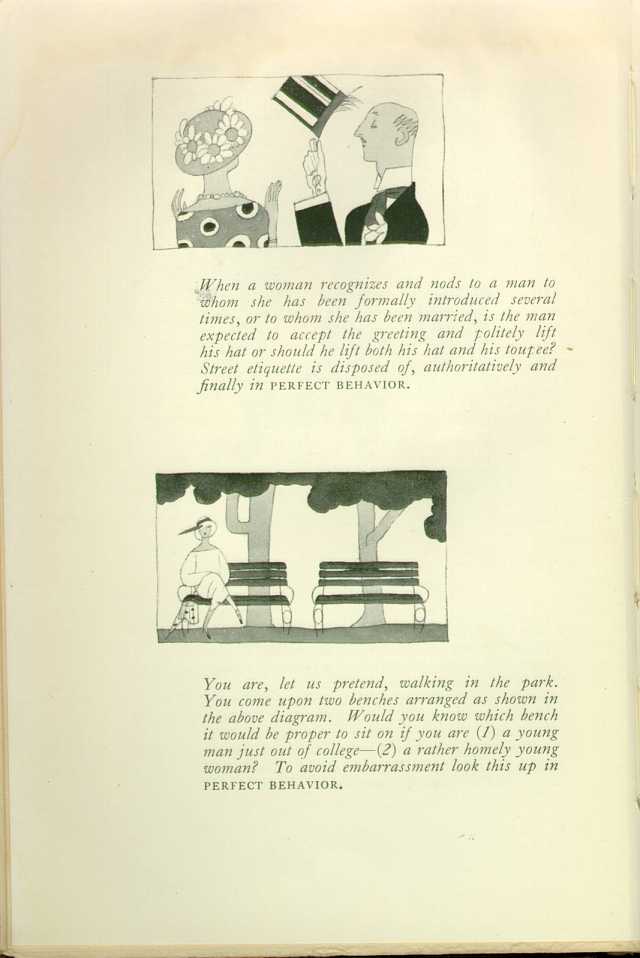
You are, let us pretend, walking in the park. You come upon two benches arranged as shown in the above diagram. Would you know which bench it would be proper to sit on if you are (1) a young man just out of college—(2) a rather homely young woman? To avoid embarrassment look this up in PERFECT BEHAVIOR.
[Description: Drawing of a woman sitting on a park bench with an empty bench immediately to her left. ]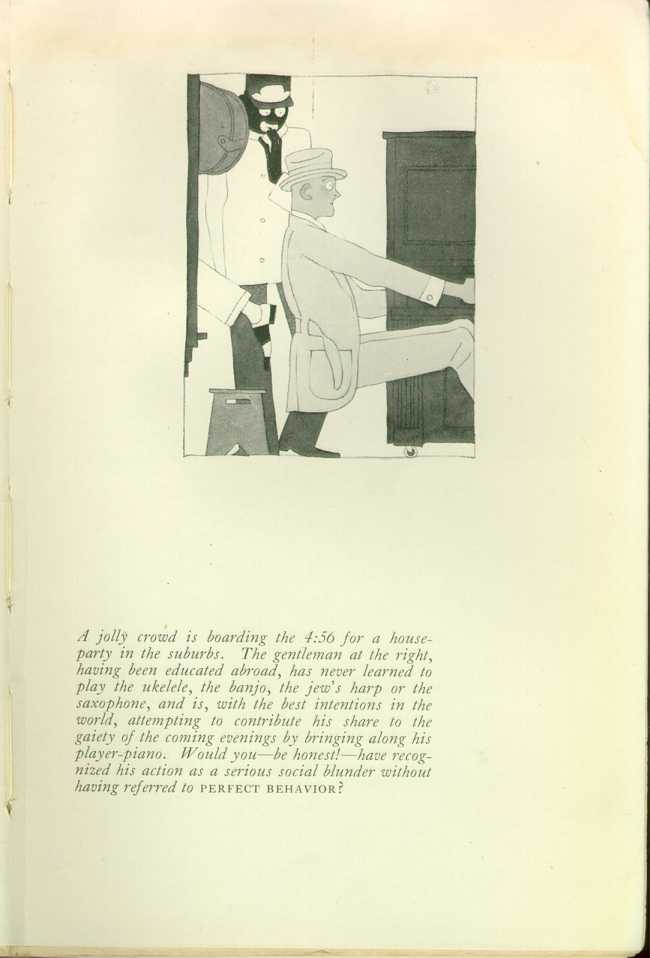
A jolly crowd is boarding the 4:56 for a house-party in the suburbs. The gentleman at the right, having been educated abroad, has never learned to play the ukelele, the banjo, the jew's harp or the saxophone, and is, with the best intentions in the world, attempting to contribute his share to the gaiety of the coming evenings by bringing along his player-piano. Would you—be honest!—have recognized his action as a serious social blunder without having referred to PERFECT BEHAVIOR?
[Description: Drawing of a man holding a large object. Another man stands behind him with his hand to his face. ]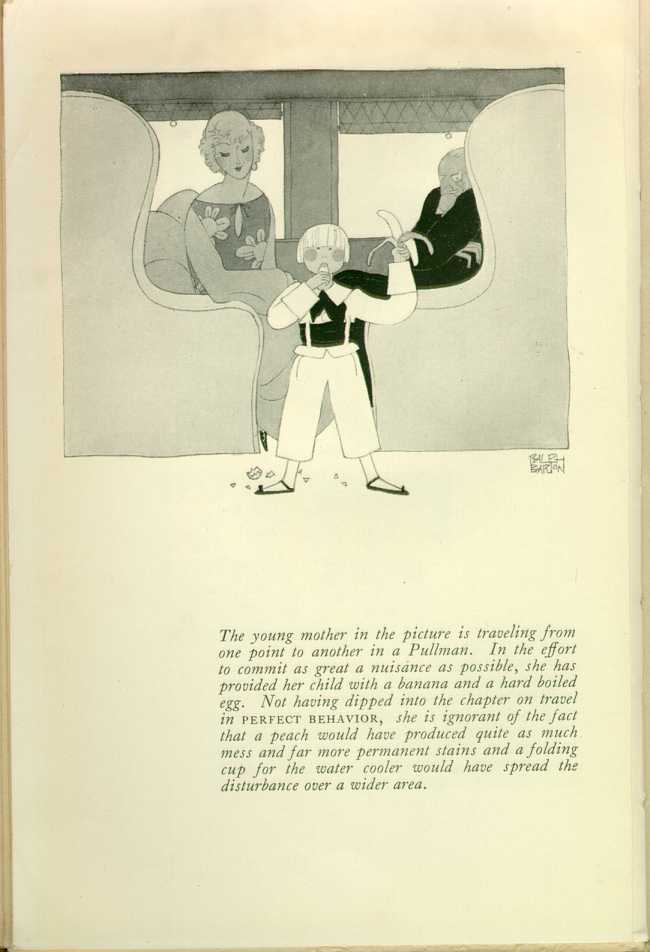
The young mother in the picture is traveling from one point to another in a Pullman. In the effort to commit as great a nuisance as possible, she has provided her child with a banana and a hard boiled egg. Not having dipped into the chapter on travel in PERFECT BEHAVIOR, she is ignorant of the fact that a peach would have produced quite as much mess and far more permanent stains and a folding cup for the water cooler would have spread the disturbance over a wider area.
[Description: Drawing of a child standing in a railroad car holding a banana and eating an egg. A pleased looking woman and an irritated man sit in the seats behind him. ]Within a week after you have sent the young lady the flowers, you should receive a polite note of thanks, somewhat as follows: "My dear Mr. Roe: Those lovely flowers came quite as a surprise. They are lovely, and I cannot thank you enough for your thoughtfulness. Their lovely fragrance fills my room as I write, and I wish to thank you again. It was lovely of you."
FLOWERS AND THEIR MESSAGE IN COURTSHIP
IT is now time to settle down to the more serious business of courtship. Her letter shows beyond the shadow of a figurative doubt that she is "interested," and the next move is "up to you." Probably she will soon come into the office to see her father, in which case you should have ready at hand some appropriate gift, such as, for example, a nice potted geranium. Great care should be taken, however, that it is a plant of the correct species,
Fringed Gentian—"I am going out to get a shave. Back at 3:30."
Poppy—"I would be proud to be the father of your children."
Golden-rod—"I hear that you have hay-fever."
Tuberose—"Meet me Saturday at the Fourteenth Street subway station."
Blood-root—"Aunt Kitty murdered Uncle Fred Thursday."
Dutchman's Breeches—"That case of Holland gin and Old Tailor has arrived. Come on over."
Iris—"Could you learn to love an optician?"
Aster—"Who was that stout Jewish-looking party I saw you with in the hotel lobby Friday?"
Deadly Nightshade—"Pull down those blinds, quick!"
Passion Flower—"Phone Main 1249—ask for Eddie."
Raspberry—"I am announcing my engagement to Charlie O'Keefe Tuesday."
Wild Thyme—"I have seats for the Hippodrome Saturday afternoon."
The above flowers can also be combined to make different meanings, as, for example, a bouquet composed of three tuberoses and some Virginia creeper generally signifies the following, "The reason I didn't call for you yesterday was that I had three inner tube punctures, besides a lot of engine trouble in that old car I bought in Virginia last year. Gosh, I'm sorry!"
But to return to the etiquette of our present courtship. As Miss Doe leaves the office you follow her, holding the potted plant in your
RECEIVING AN INVITATION TO CALL
LET us suppose, however, that she accepts the geranium in such a manner that you are encouraged to continue the acquaintance. Your next move should be a request for an
THE ETIQUETTE OF TELEPHONING
ON Thursday morning, therefore, you should go to a public telephone-booth in order to call the young lady's house. The etiquette of telephoning is quite important and many otherwise perfectly well-bred people often make themselves conspicuous because they do not know the correct procedure in using this modern but almost indispensable invention. Upon entering the telephone-booth, which is located, say, in some drug store, you remove the receiver from the hook and deposit the requisite coin in the coin box. After an interval of some minutes a young lady (referred to as "Central") will ask for your "Number, please." Suppose, for example, that you wish to get Bryant 4310. Remove your hat politely and speak that number into the mouthpiece. "Central" will then say, "Rhinelander 4310." To which you reply, "No, Central—Bryant 4310." Central then says, "I beg your pardon—Bryant 4310," to which you reply, "Yes, please." In a few minutes
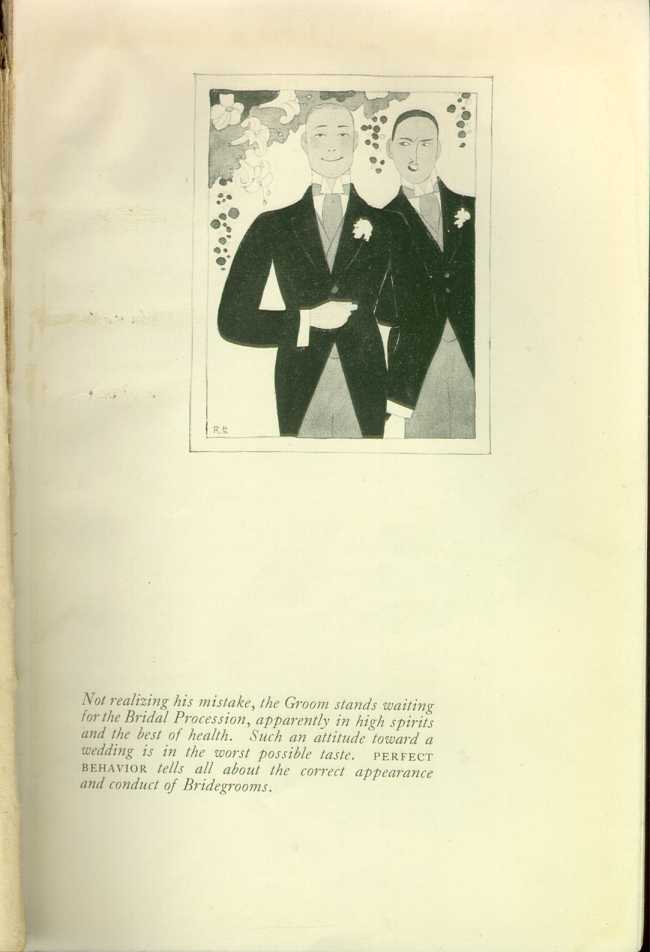
Not realizing his mistake, the Groom stands waiting for the Bridal Procession, apparently in high spirits and the best of health. Such an attitude toward a wedding is in the worst possible taste. PERFECT BEHAVIOR tells all about the correct appearance and conduct of Bridegrooms.
[Description: Drawing of a Groom, dressed in a tuxedo, looking straight ahead with a smile on his face. Another man in a tuxedo stands to his left with a sneer on his face. ]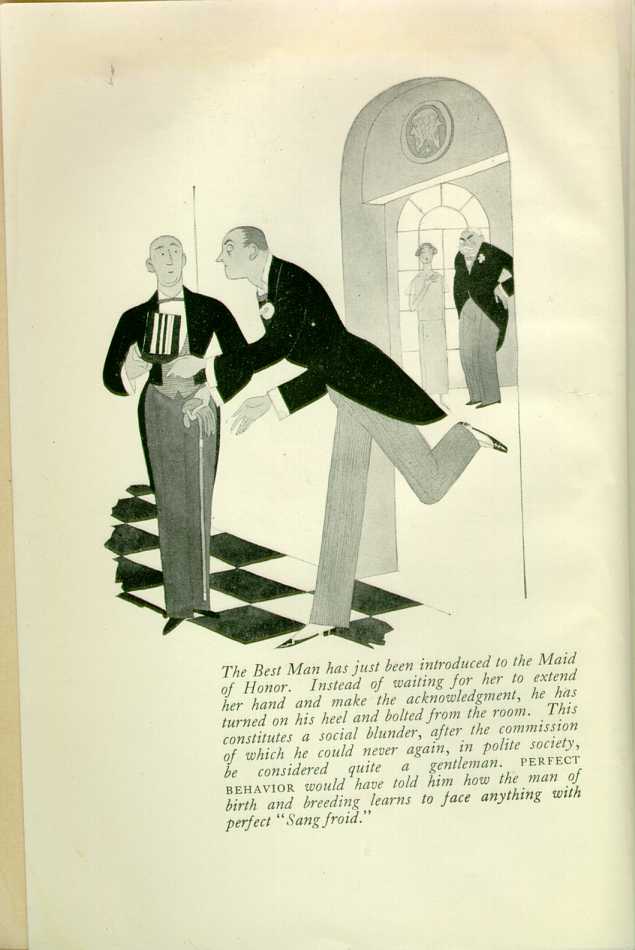
The Best Man has just been introduced to the Maid of Honor. Instead of waiting for her to extend her hand and make the acknowledgment, he has turned on his heel and bolted from the room. This constitutes a social blunder, after the commission of which he could never again, in polite society, be considered quite a gentleman. PERFECT BEHAVIOR would have told him how the man of birth and breeding learns to face anything with perfect "Sang froid."
[Description: Drawing of a man running out a room in which a surprised young lady and an older gentlemen stand. ]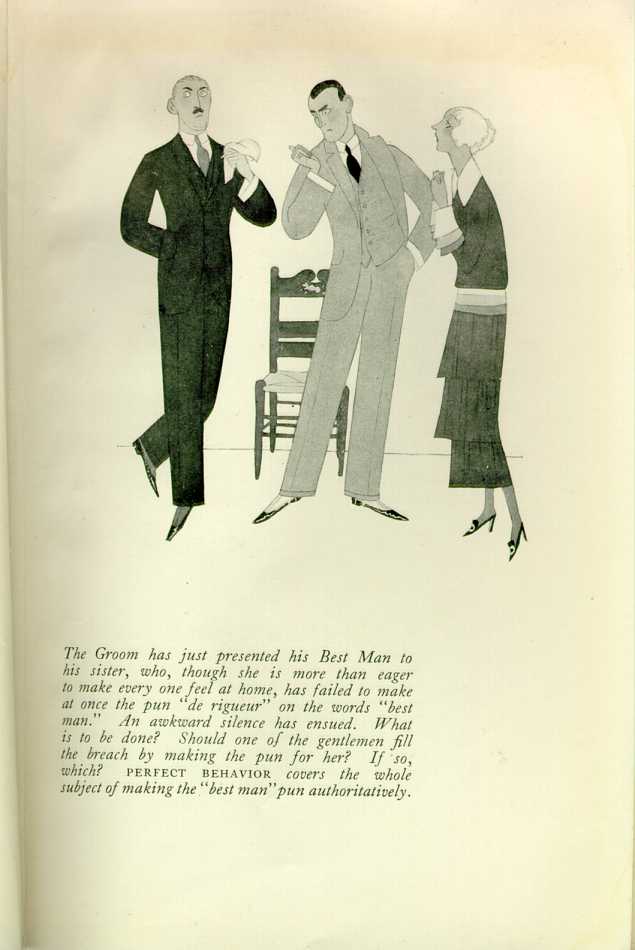
The Groom has just presented his Best Man to his sister, who, though she is more than eager to make every one feel at home, has failed to make at once the pun "de rigueur" on the words "best man." An awkward silence has ensued. What is to be done? Should one of the gentlemen fill the breach by making the pun for her? If so, which? PERFECT BEHAVIOR covers the whole subject of making the "best man" pun authoritatively.
[Description: Drawing of two men and a woman in the midst of an awkward silence. ]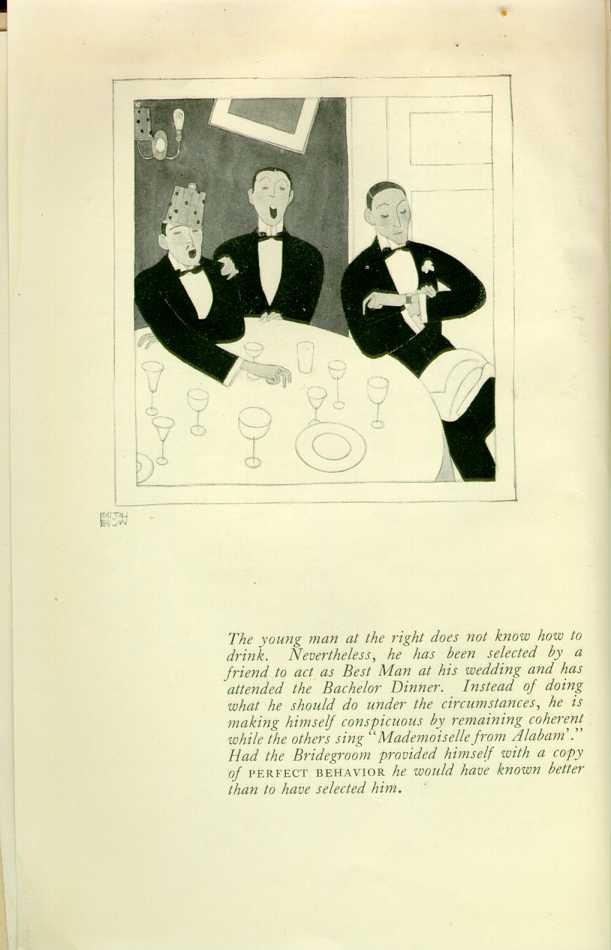
The young man at the right does not know how to drink. Nevertheless, he has been selected by a friend to act as Best Man at his wedding and has attended the Bachelor Dinner. Instead of doing what he should do under the circumstances, he is making himself conspicuous by remaining coherent while the others sing "Mademoiselle from Alabam." Had the Bridegroom provided himself with a copy of PERFECT BEHAVIOR he would have known better than to have selected him.
[Description: Drawing of three men sitting at a table. Two of the men are singing and partying, the other man is looking at his watch. ]MAKING THE FIRST CALL
THE custom of social "calls" between young men and young women is one of the prettiest of etiquette's older conventions, and one around which clusters a romantic group of delightful traditions. In this day and generation, what with horseless carriages,
The first call at the home of any young lady of fashion is an extremely important social function, and too great care can not be taken that you prepare yourself thoroughly in advance. It would be well to leave your work an hour or two earlier in the afternoon, so that you can go home and practice such necessary things as entering or leaving a room correctly. Most young men are extremely careless in this particular, and unless you rehearse yourself thoroughly in the proper procedure you are apt to find later on to your dismay that
CONVERSATION AND SOME OF ITS USES
YOUR conversation should also be planned more or less in advance. Select some topic in which you think your lady friend will be interested, such as, for example, the removal of tonsils and adenoids, and "read up" on the subject so that you can discuss it in an intelligent manner. Find out, for example, how many people had tonsils removed in February, March, April. Contrast this with the same figures for 1880, 1890, 1900. Learn two or three amusing anecdotes about adenoids. Consult Bartlett's "Familiar Quotations" for appropriate verses dealing with tonsils and throat troubles. Finally, and above all, take time to glance through four or five volumes of Dr. Eliot's Five Foot Shelf, for nothing so completely marks the cultivated man as the ability to refer familiarly to the various volumes of the Harvard classics.
A PROPER CALL
PROMPTLY at the time appointed you should arrive at the house where the young lady is staying. In answer to your ring a German police dog will begin to bark furiously inside the house, and a maid will finally come to the door. Removing your hat and one glove, you say, "Is Miss Doe home?" The maid replies, "Yass, ay tank so." You give her your card and the dog rushes out and bites you on either the right or left leg. You are then ushered into a room in which is seated an old man with a long white beard. He is fast asleep. "Dot's grampaw," says the maid, to which you reply, "Oh." She retires, leaving you alone with grampaw. After a while he opens his eyes and stares at you for a few minutes. He then says, "Did the dog bite you?" You answer, "Yes, sir." Grampaw then says, "He bites everybody," and goes back to sleep. Reassured, you light a cigaret. A little boy and girl then come to the door, and, after examining you carefully for several
Finally Miss Doe arrives. Her first words are, "Have you been waiting long? Hilda didn't tell me you were here," to which you reply, "No—I just arrived." She then says, "Shall we go in the drawing-room?" The answer to this is, "For God's sake, yes!" In a few minutes you find yourself alone in the drawing-room with the lady of your choice and the courtship proper can then begin.
The best way to proceed is gradually to bring the conversation around to the subject of the "modern girl." After your preliminary remarks about tonsils and adenoids have been thoroughly exhausted, you should suddenly say, "Well I don't think girls—nice girls—are really that way." She replies, of course, "What way?" You answer, "Oh, the way they
On your first visit you should not stay after 12:30.
THE PROPOSAL PROPER
ABOUT the second or third month of a formal courtship it is customary for the man to propose matrimony, and if the girl has been "out" for three or four years and has several younger sisters coming along, it is customary for her to accept him. They then become "engaged," and the courtship is concluded.
|
CHAPTER ONE: THE ETIQUETTE OF COURTSHIP
Perfect Behavior | ||